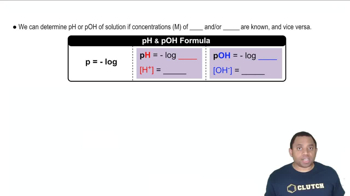Here are the essential concepts you must grasp in order to answer the question correctly.
Concentration and Mass Percent
Mass percent is a way of expressing the concentration of a solution, defined as the mass of solute divided by the total mass of the solution, multiplied by 100. In this case, a 15.0% by mass NaOH solution means that there are 15 grams of NaOH in every 100 grams of the solution. Understanding this concept is crucial for calculating the amount of NaOH needed to achieve the desired pH in the final solution.
Recommended video:
pH and pOH Relationship
pH is a measure of the acidity or basicity of a solution, with lower values indicating higher acidity and higher values indicating higher basicity. The pH scale ranges from 0 to 14, where a pH of 7 is neutral. For a solution with a pH of 10.8, it is basic, and the corresponding pOH can be calculated using the formula pOH = 14 - pH. This relationship is essential for determining the concentration of hydroxide ions in the solution.
Recommended video:
Density and Volume Calculations
Density is defined as mass per unit volume and is crucial for converting between mass and volume of a solution. In this problem, the density of the NaOH solution is given as 1.116 g/mL, which allows us to calculate the mass of the solution needed to achieve the desired concentration. By using the density, we can convert the mass of NaOH required into the corresponding volume of the 15.0% solution.
Recommended video:

 Verified step by step guidance
Verified step by step guidance

